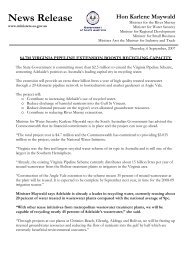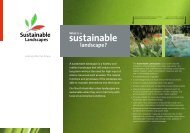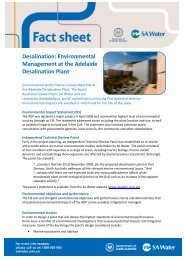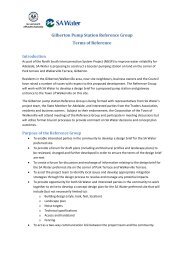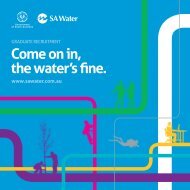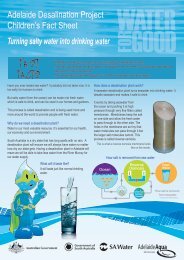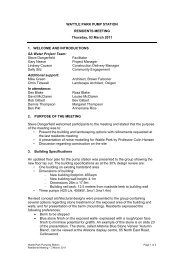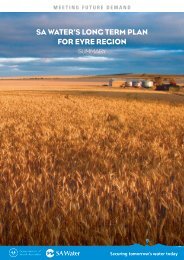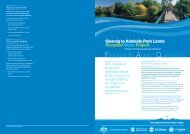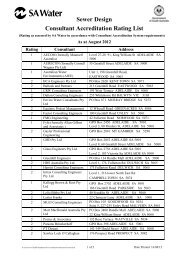Code of Practice - Irrigated Public Open Space - SA Water
Code of Practice - Irrigated Public Open Space - SA Water
Code of Practice - Irrigated Public Open Space - SA Water
Create successful ePaper yourself
Turn your PDF publications into a flip-book with our unique Google optimized e-Paper software.
5.0 TURF & IRRIGATION MANAGEMENT PRINCIPLES<br />
5.1 Irrigation system design<br />
Irrigation systems must be designed to ensure the efficient,<br />
uniform application <strong>of</strong> water to the site. Design should be<br />
aimed at conserving and protecting water resources. Design<br />
should take into consideration agronomic, climatic and water<br />
supply issues to ensure that the system can operate effectively.<br />
Guidelines for the design <strong>of</strong> urban irrigation systems have<br />
been developed by Irrigation Australia Limited and can be<br />
accessed in the IAL publication, Urban Irrigation Best<br />
<strong>Practice</strong> Guidelines (2006).<br />
An irrigation design brief should be prepared to ensure the<br />
designer meets all appropriate requirements <strong>of</strong> the urban<br />
irrigation best management practice guidelines.<br />
Issues considered in the design should include:<br />
• Soil type and structure.<br />
• Infiltration rate.<br />
• Plant species.<br />
• Root zone depth.<br />
• Average and forecasted climatic data (ETo/rainfall).<br />
• <strong>Water</strong> quality, pressure and flow rate parameters.<br />
• Scheduling restrictions.<br />
• Use <strong>of</strong> technology to enhance water management such as,<br />
weather stations, moisture sensors, rain sensors,<br />
computerised irrigation management systems.<br />
ABOVE GROUND OR SUB-SURFACE IRRIGATION<br />
When planning and designing an irrigation system a critical decision<br />
is whether to use a traditional above ground pop-up irrigation<br />
system or alternatively a sub-surface in-line drip irrigation system.<br />
Sub-surface drip technology for turf has advanced significantly in<br />
recent years with systems performing to a high standard. The<br />
benefits <strong>of</strong> correctly designed, installed and maintained sub-surface<br />
drip include;<br />
• Highdistributionuniformityduetoelimination<strong>of</strong>theeffects<strong>of</strong><br />
wind, misting, poorly aligned sprinklers. As a general rule a high<br />
performing sub-surface drip system can achieve DU ratings <strong>of</strong><br />
between 80 – 90% while similar pop up systems will achieve<br />
between 70 – 80%.<br />
• Sub-surfacedripcanbescheduledatanytimeasitisnoteffected<br />
by evaporation and does not effect the turf surface.<br />
• <strong>Water</strong>isapplieddirectlytotherootzoneandcanbescheduled<br />
daily to replace evapotranspiration losses, keeping the available<br />
water at optimum levels.<br />
• Vandalismisreducedastherearenoabovegroundcomponents<br />
such as pop up sprinklers.<br />
• Installationcanberetr<strong>of</strong>ittedintoestablishedturf.<br />
10<br />
New systems should be designed to meet following<br />
standards:<br />
• A system application rate <strong>of</strong> between 11 – 15mm per hour.<br />
• Lower Quarter Distribution Uniformity (DU) measure <strong>of</strong><br />
>85% which must equate to a field DU >75%. DU is the<br />
unit <strong>of</strong> measure used to determine the performance <strong>of</strong> turf<br />
irrigation systems. DU is defined as “the average water<br />
applied in the 25% <strong>of</strong> the area receiving the least amount<br />
<strong>of</strong> water, regardless <strong>of</strong> location within the pattern, divided<br />
by the average water applied over the total area.”<br />
(refer IAL – Certified Irrigation Audit Manual, 2004.)<br />
Design documentation to include:<br />
• Irrigation plans.<br />
• Design parameters (flow, pressure, DU, precipitation rate).<br />
• Installation specification including component<br />
specification to meet appropriate Australian standards.<br />
• Quality control inspection procedures.<br />
• <strong>Water</strong> budget.<br />
• Irrigation schedule.<br />
Irrigation systems should be designed by qualified irrigation<br />
designers (refer section 8.0 – Training & Certification)<br />
However, not all situations are suitable for sub-surface drip.<br />
Some drawbacks include:<br />
• Highercapitalcostforsub-surfacesystems.<br />
• Somesoiltypes(egcoarsesands)donotallowsufficientlateral<br />
water movement through the soil pr<strong>of</strong>ile.<br />
• Wheresuitablesoiltypeisnot<strong>of</strong>aconsistentfriablestructure,<br />
vertical channelling <strong>of</strong> water can result causing the leaching <strong>of</strong><br />
fines and poor lateral movement <strong>of</strong> water.<br />
• Therecanbedifficultyinestablishingnewturf.<br />
• Intrusion<strong>of</strong>rootsintothedriplinescanbeaproblemifnot<br />
addressed in irrigation practices.<br />
• Turfrenovationpractices(egaerationanddecompaction)mustbe<br />
modified to ensure damage does not occur to the in-line drip lines<br />
set at approximately 200mm below the surface.<br />
• Eventmanagementmustconsidertheimpact<strong>of</strong>heavymachinery<br />
and the erection <strong>of</strong> marquis, or other variables in relation to<br />
sub-surface drip lines.<br />
Regardless <strong>of</strong> the choice to have above ground or sub-surface<br />
irrigation systems it is critical that design, installation and<br />
maintenance is <strong>of</strong> the highest standard.<br />
For advice on system selection consult a qualified irrigation designer<br />
or irrigation manager.



